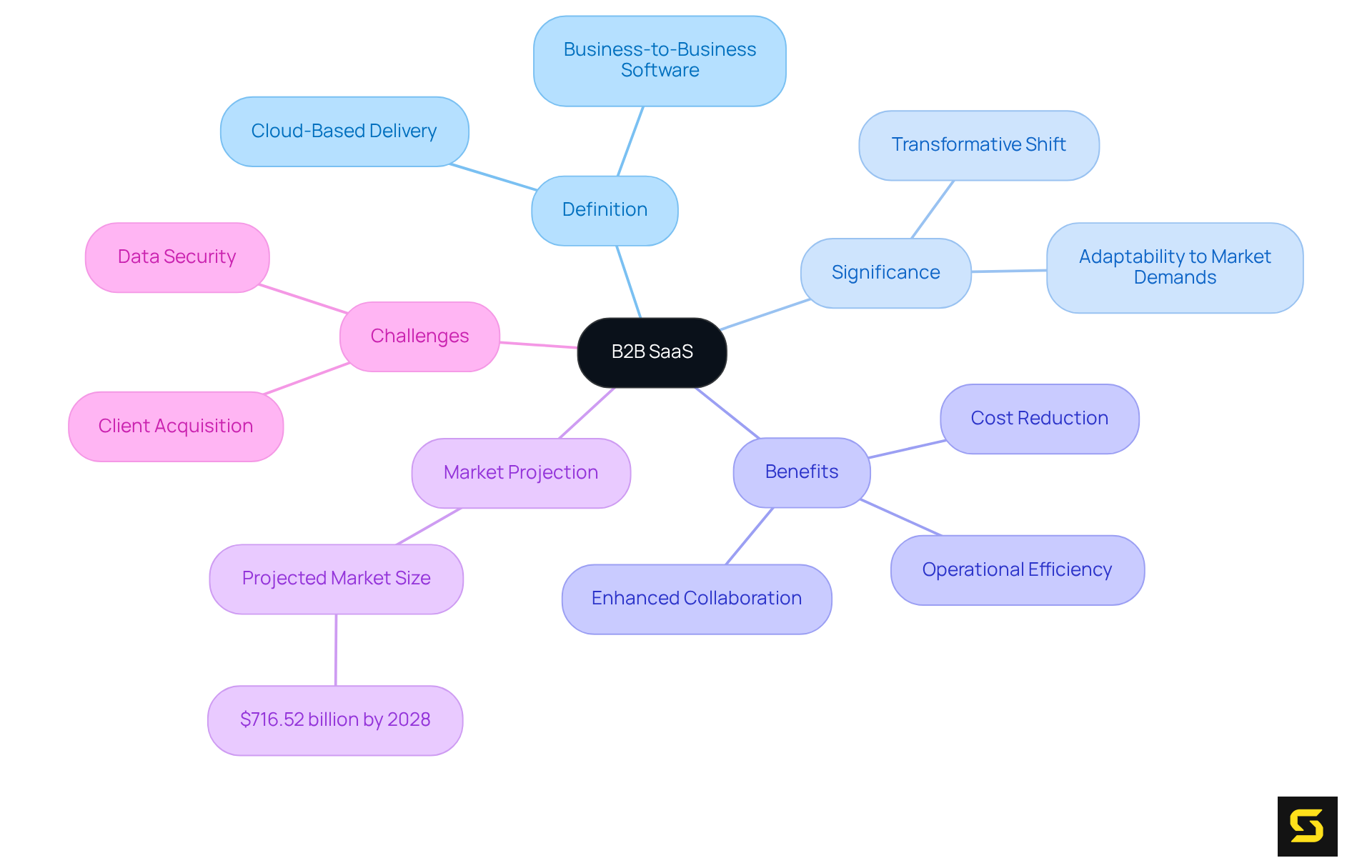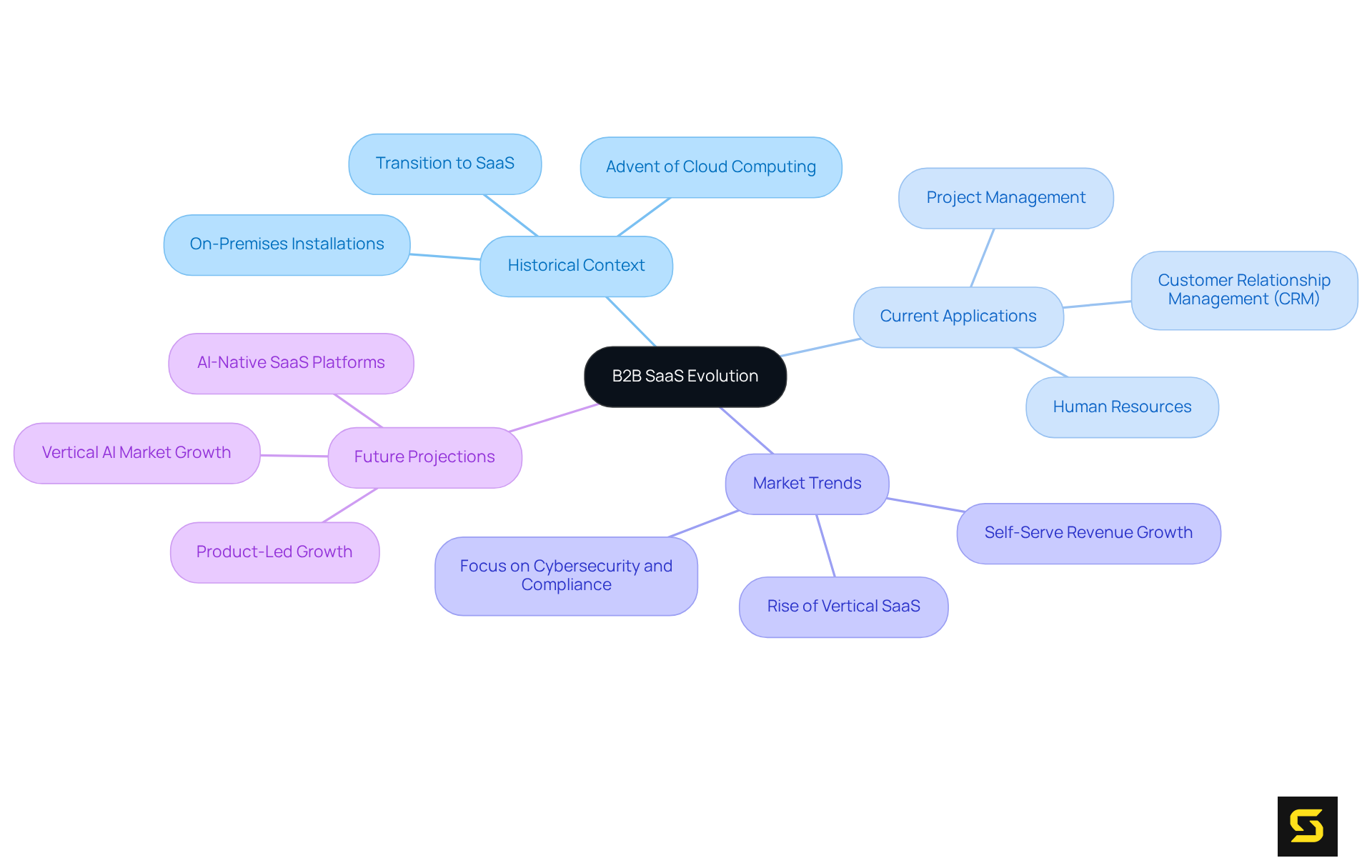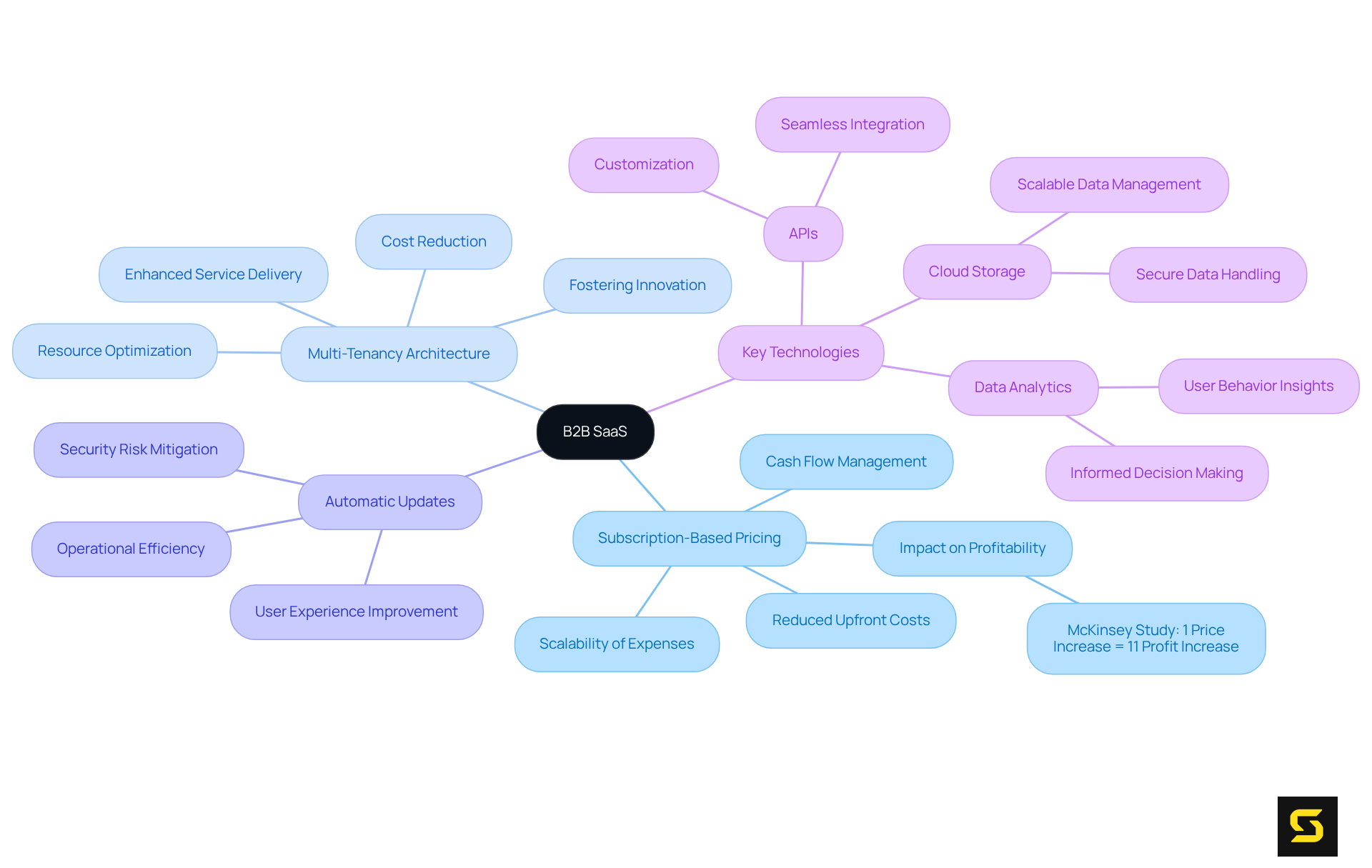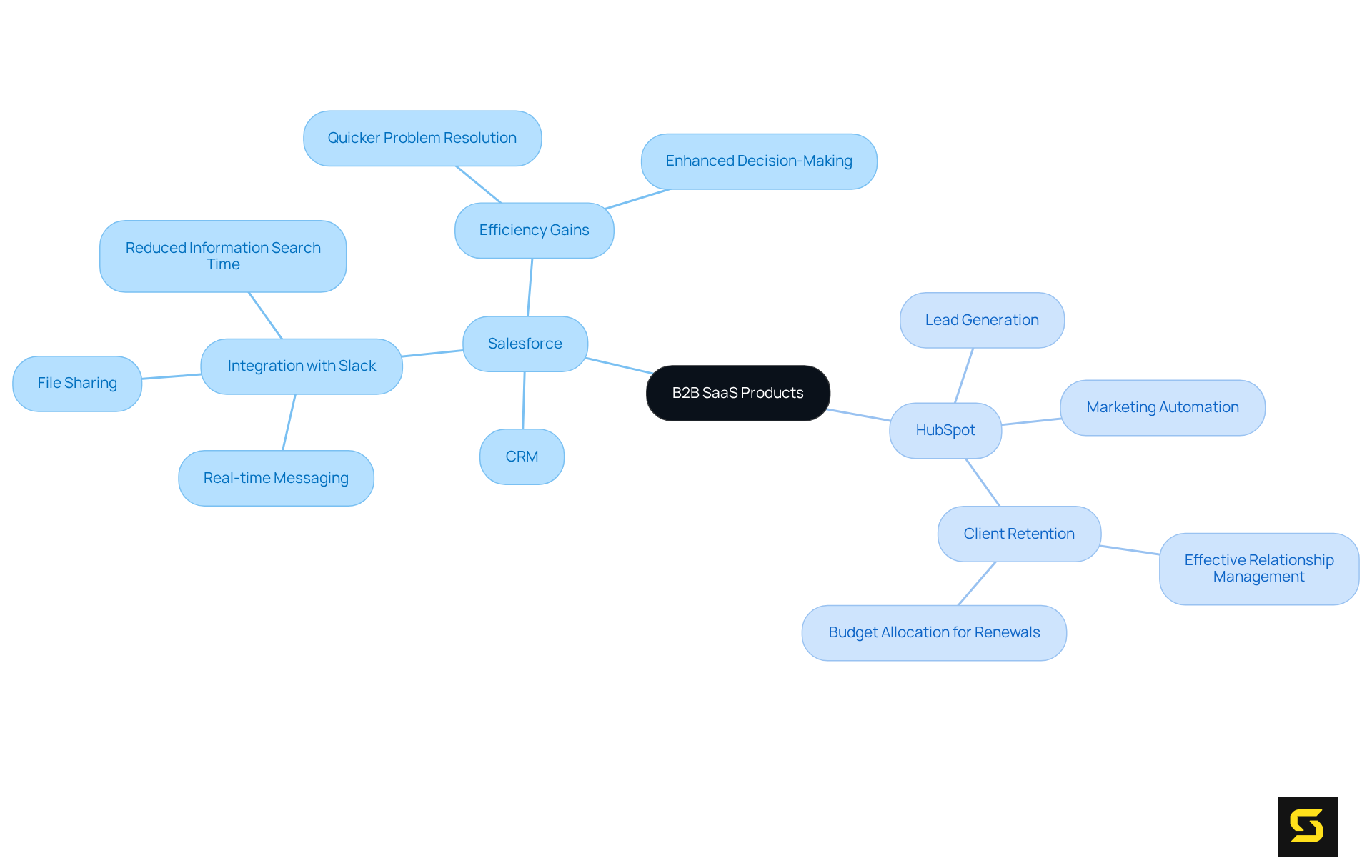Overview
B2B SaaS, or Business-to-Business Software as a Service, represents a transformative cloud-based model that empowers companies to access software solutions online. This innovation enhances operational efficiency and adaptability while simultaneously reducing costs. The importance of B2B SaaS is underscored by its ability to revolutionize business processes through key features such as:
- Subscription pricing
- Multi-tenancy architecture
- Automatic updates
Collectively, these elements facilitate scalability and optimize resource management, positioning B2B SaaS as an essential tool for modern enterprises.
Introduction
The landscape of business software is experiencing a significant transformation, propelled by the emergence of Business-to-Business Software as a Service (B2B SaaS). This groundbreaking model not only boosts operational efficiency but also redefines how companies access and utilize software solutions, empowering them to excel in an increasingly competitive marketplace.
As organizations confront the challenges of client acquisition, data security, and shifting market demands, a critical question emerges: how can businesses effectively harness B2B SaaS to unlock new opportunities and propel sustainable growth?
Define B2B SaaS: Meaning and Significance
What is B2B SaaS represents a in how companies access software solutions, as it refers to Business-to-Business Software delivered through the cloud. Unlike traditional software requiring local installation, B2B cloud applications are hosted online, facilitating easy access and scalability. This innovative model empowers businesses to streamline operations, reduce costs, and enhance collaboration by providing tools accessible from any location with internet connectivity.
The significance of what is B2B SaaS is highlighted by its ability to revolutionize processes, making them more efficient and adaptable to evolving market demands. Organizations leveraging B2B software solutions have reported remarkable improvements in operational efficiency and productivity. Many have noted a reduction in client acquisition costs and enhanced client engagement.
As the B2B software market is projected to reach $716.52 billion by 2028, its role in driving innovation and adaptability for enterprises becomes increasingly vital. However, it is essential for companies to navigate challenges such as client acquisition and retention while addressing data security and privacy concerns inherent in these solutions.

Contextualize B2B SaaS: Evolution and Market Relevance
The evolution of the B2B software-as-a-service model raises the question, what is B2B SaaS, since its inception in the early 2000s. Initially, software was predominantly delivered through on-premises installations, necessitating substantial upfront investments and ongoing maintenance. The advent of cloud computing revolutionized this landscape, empowering software providers to offer scalable solutions accessible via the internet. Today, B2B software as a service stands as a multi-billion dollar industry, with companies leveraging these solutions for a wide array of functions, including:
- Customer relationship management (CRM)
- Project management
- Human resources
As organizations seek flexible, cost-efficient solutions that can adapt to their evolving requirements, understanding what is B2B SaaS becomes increasingly important in the expanding market relevance of B2B software. Notably, companies transitioning from zero to $500K in self-serve revenue experience a 14.5% improvement in overall performance scores, highlighting the advantages of self-serve models. Additionally, vertical software solutions tailored for specific industries are witnessing rapid growth, with vertical AI markets projected to outpace general software by a factor of ten over the next decade. Furthermore, there is an increasing emphasis on cybersecurity and compliance in B2B software for 2025, reflecting the shifting priorities of buyers in the market.

Explore Key Characteristics: Components and Technologies of B2B SaaS
Understanding what is B2B SaaS involves recognizing key characteristics such as subscription-based pricing, multi-tenancy architecture, and automatic updates. Subscription-based pricing models present significant advantages, enabling businesses to manage cash flow more effectively by spreading costs over monthly or annual payments. This model alleviates the financial burden of large upfront investments and , facilitating easier scaling of software expenses as needs grow. Notably, a McKinsey study reveals that even a minor price increase can lead to an 11% boost in profitability, underscoring the critical role of pricing strategies in software as a service.
Multi-tenancy architecture stands out as another essential feature, allowing a single instance of the software to serve multiple customers. This approach optimizes resource utilization, reduces operational costs, and enhances overall service delivery efficiency. By sharing resources, software-as-a-service providers can offer competitive pricing while maintaining high service levels. Industry experts assert that this model is vital for fostering innovation and ensuring services remain accessible to a broader range of businesses.
Automatic updates are indispensable in the B2B software environment, guaranteeing that all users benefit from the latest features and security improvements without manual intervention. This enhances user experience and mitigates security risks associated with outdated software. As Erica Sandelin Ekelund emphasizes, prioritizing operational efficiency and customer retention is crucial in today’s competitive landscape.
Technologies such as APIs, cloud storage, and data analytics are fundamental to what is B2B SaaS and the functionality of B2B software services. APIs enable seamless integration with other organizational systems, enhancing interoperability and allowing entities to create tailored solutions. Cloud storage provides scalable and secure data management, while data analytics delivers valuable insights into user behavior, empowering companies to make informed decisions and optimize operations. As the software-as-a-service market evolves, these elements will play a pivotal role in shaping the future of enterprise software, particularly with the emergence of hybrid and usage-based pricing models that cater to diverse client needs.

Illustrate with Examples: B2B SaaS Products in Action
What is B2B SaaS? It encompasses products that have made substantial impacts across diverse industries. Take Salesforce, for instance—a leading CRM platform that empowers organizations to manage client relations and sales processes with remarkable efficiency. Its integration with Slack has transformed team communication, enabling real-time messaging and file sharing. Early tests indicate a reduction in information search time by as much as 30%. This integration not only facilitates quicker problem resolution but also enhances decision-making, particularly within hybrid human-AI teams.
Another prime example is HubSpot, which delivers robust marketing automation solutions that enable companies to streamline their marketing efforts and boost lead generation. With 85% of software-as-a-service budgets allocated to renewals, like HubSpot are indispensable for client retention and managing ongoing expenses.
These instances highlight what is B2B SaaS, illustrating how B2B software products can significantly enhance operational efficiency, foster customer engagement, and propel organizational growth. As the SaaS market is projected to surpass $225 billion by 2025, the importance of these tools in modern business operations continues to escalate, affirming their critical role in today’s digital landscape.

Conclusion
Understanding B2B SaaS is crucial for businesses aiming to thrive in an increasingly digital landscape. This model not only streamlines operations and reduces costs but also enhances collaboration through cloud-based solutions accessible from anywhere. The transformative nature of B2B SaaS positions it as an essential tool for organizations seeking to improve efficiency and adaptability in a rapidly changing market.
Key insights from the article highlight the evolution of B2B SaaS from traditional software delivery methods to a robust, scalable model that supports various business functions, including CRM and project management. The advantages of subscription-based pricing, multi-tenancy architecture, and automatic updates further emphasize how B2B SaaS can drive operational efficiency and profitability. Moreover, the growing emphasis on cybersecurity and compliance reflects the changing priorities of businesses as they navigate the complexities of the digital era.
As the B2B SaaS market continues to expand, with projections indicating a substantial increase in value, companies must recognize the significance of adopting these solutions. Engaging with B2B SaaS not only enhances operational capabilities but also fosters innovation and competitive advantage. Embracing this model is not merely a trend; it is a strategic imperative that can shape the future of business operations. Therefore, it is essential for organizations to invest in and leverage B2B SaaS to secure their position in the market.
Frequently Asked Questions
What does B2B SaaS stand for?
B2B SaaS stands for Business-to-Business Software as a Service, which refers to software solutions delivered through the cloud for use by businesses.
How does B2B SaaS differ from traditional software?
Unlike traditional software that requires local installation, B2B SaaS applications are hosted online, allowing for easy access and scalability from any location with internet connectivity.
What are the benefits of using B2B SaaS?
B2B SaaS helps businesses streamline operations, reduce costs, and enhance collaboration, leading to improvements in operational efficiency and productivity.
What impact does B2B SaaS have on client acquisition and engagement?
Organizations using B2B SaaS solutions have reported a reduction in client acquisition costs and enhanced client engagement.
What is the projected growth of the B2B software market?
The B2B software market is projected to reach $716.52 billion by 2028.
What challenges do companies face when implementing B2B SaaS?
Companies must navigate challenges such as client acquisition and retention, as well as address data security and privacy concerns associated with these solutions.





